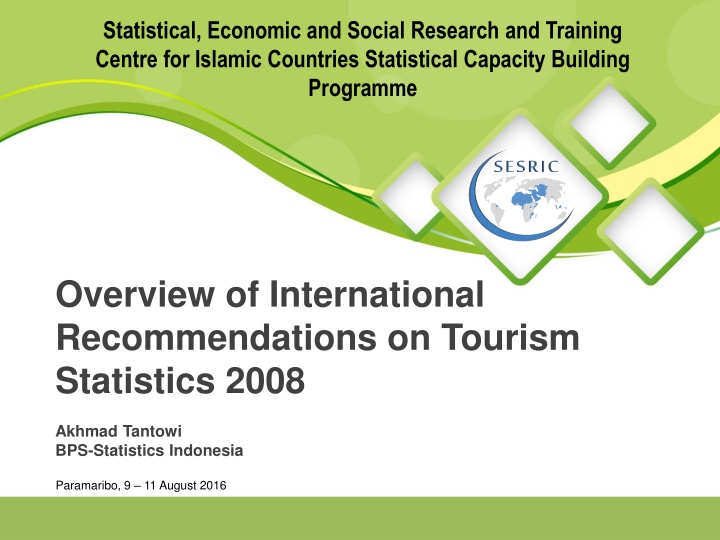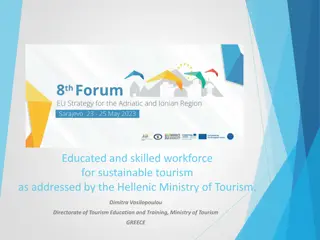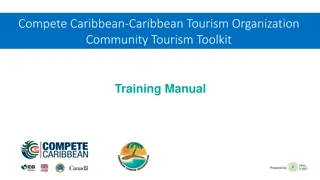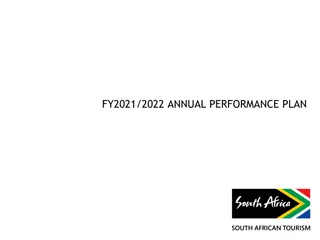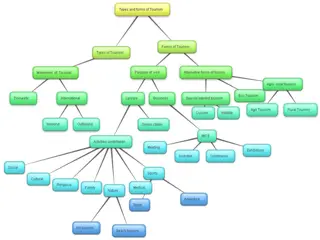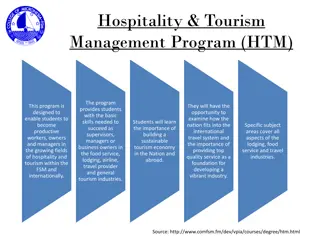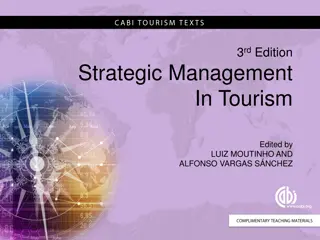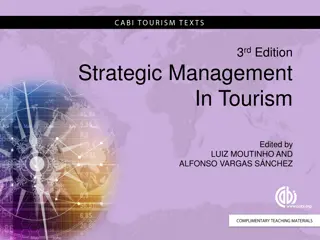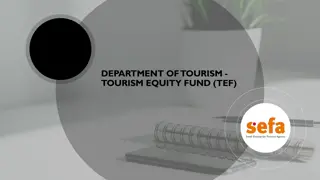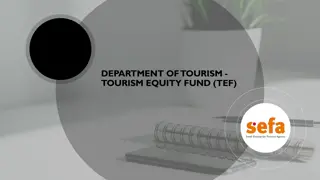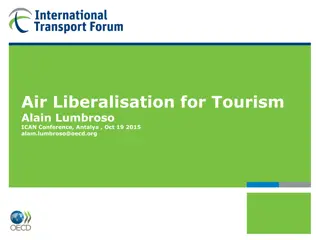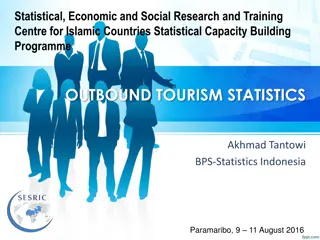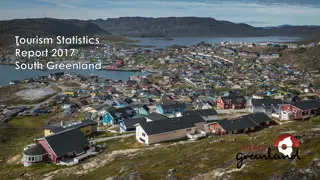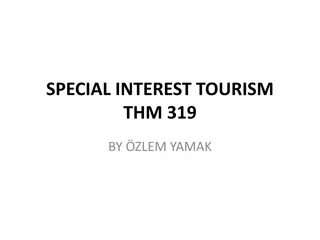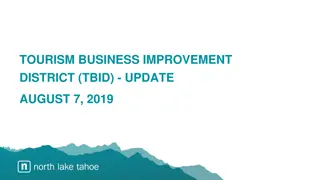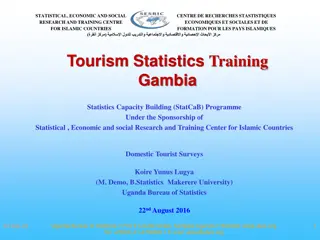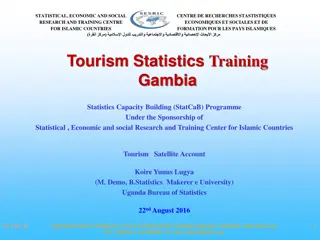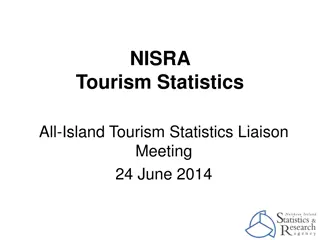Overview of International Recommendations on Tourism Statistics
The article highlights the evolution of international standards in tourism statistics, focusing on the need for new standards, historical background, and the adoption of the International Recommendations for Tourism Statistics in 2008.
Download Presentation

Please find below an Image/Link to download the presentation.
The content on the website is provided AS IS for your information and personal use only. It may not be sold, licensed, or shared on other websites without obtaining consent from the author.If you encounter any issues during the download, it is possible that the publisher has removed the file from their server.
You are allowed to download the files provided on this website for personal or commercial use, subject to the condition that they are used lawfully. All files are the property of their respective owners.
The content on the website is provided AS IS for your information and personal use only. It may not be sold, licensed, or shared on other websites without obtaining consent from the author.
E N D
Presentation Transcript
Statistical, Economic and Social Research and Training Centre for Islamic Countries Statistical Capacity Building Programme Overview of International Recommendations on Tourism Statistics 2008 Akhmad Tantowi BPS-Statistics Indonesia Paramaribo, 9 11 August 2016 Paramaribo, 9 11 August 2016
Outline Historical background New standards What is tourism? Form of tourism Who is visitor? Characteristics of visitors Tourism expenditure Basic information framework for international comparability Other issues
Historical Background in the pre-standards days, everybody developed their own concepts, definitions and classifications countries could not compare statistics between collections or over time no international comparisons were possible with the growing impact of tourism on economy, countries and organisations like UNWTO saw the need for international standards the first set of comprehensive international standards were produced in 1993: the 1993 Recommendations on Tourism Statistics however, in recent years it has been seen that these standards were no longer sufficient and needed to be revised
Why do we need new standards? as a specialised agency of the United Nations, UNWTO has greater responsibility to integrate the system of tourism statistics into the international standards for all economic activities the development of the TSA in conformity with the UN System of National Accounts and the IMF Balance of Payments standards has required some changes relevant international frameworks (to which tourism statistics are related), such as SNA, BPM, CPC, ISIC and the MSITS, were updated and revised
The new standards 2008 International Recommendations for Tourism Statistics (IRTS 2008) was ratified by the United Nations Statistical Commission at its 39thmeeting in New York in February/March 2008 presents a system of definitions, concepts, classifications and indicators that are internally consistent facilitate the link to the conceptual frameworks of the Tourism Satellite Account, the National Accounts, Balance of Payments and labour statistics
2008 INTERNATIONAL RECOMMMENDATIONS FOR TOURISM STATISTICS (IRTS)
What is tourism? tourism is a sub-set of travel Travel is defined as the activity of travellers who are people who move between different geographic locations for any purpose for any duration tourism is the activities of a sub-set of travellers, which we call visitors A Visitor is someone who takes a trip: outside his/her usual environment; for a period of less than a year; and for any purpose (business, leisure or other personal), other than to be employed by a resident entity in the country/ place visited.
What is usual environment? difficult to devise a standard definition suitable for all countries broadly usual environment of a person is the geographical area within which he/she conducts his/her regular life routines UNWTO recommends countries consider four criteria: Frequency of the trip; Duration of the trip; The crossing of administrative or national borders; and Distance from the place of usual residence.
Overnight and day visitors Overnight visitor is a visitor who stays in a place overnight. These are referred to as Tourists Same-day visitor is a visitor who returns his/her usual residence in the same day. These are called Excursionists
Employment by a resident entity excludes the travellers from being a visitor consequently, these travellers are excluded: travellers crossing the border on a regular basis for work (i.e. border workers) travellers employed under a short-term contract to work in the country however, these travellers are included: employees of non-resident entities (of the country/place visited) self-employed persons, providing services such as: installation of equipment, repair, consultancy, etc. travellers entering for business negotiations or looking for business opportunities
Inbound, Outbound, and Domestic Visitors Inbound (international) visitors are those visitors in a country whose country of residence is another country. Outbound (international) visitors are residents of a country travelling to visit another country. Domestic visitors are those visitors whose main destination is within his/her country of residence. It is possible that a Domestic visitor may also have a secondary destination in another country.
Trips, Visits and Visitors o Trip: the total travel of a visitor from departure of usual environment to return to usual environment o On one trip many places/destinations may be visited o Therefore, one trip may equal a number of visits o Sometimes, the term visitor is used for convenience instead of trip or visit o Important to be clear on what is meant and what the statistics are counting.
Characteristics of the visitor Sex Age Economic activity status Occupation Annual household, family or individual income Education
Characteristics of tourism trips Main purpose Types of Tourism product Duration of trip / visit / stay Origin and destination Modes of transport Types of accommodation
Main purpose Main purpose: The Purpose in the absence of which the trip would not have taken place. 1. Personal 1.1. 1.2. 1.3. 1.4. 1.5. 1.6. 1.7. 1.8. Holidays, leisure and recreation Visiting friends and relatives Education and training Health and medical care Religion/pilgrimages Shopping Transit Other 2. Business and professional
Modes of transport Classification of modes of transport Major groups Minor groups 1. Air 1.1 1.2 1.3 1.4 Scheduled flight Unscheduled flight Private aircraft Other modes of air transport 2. Water 2.1 2.2 2.3 2.4 Passenger line and ferry Cruise ship Yacht Other modes of water transport 3. Land 3.1 3.2 3.3 Railway Motor coach or bus and other public road transportation Vehicle rental with driver (i) taxis, limousines and rental of private motor vehicles with driver (ii) rental of man or animal drawn vehicles Owned private vehicle (with capacity up to 8 persons) Rented vehicle without operator ( ) Other modes of land transport: horseback, bicycle, motorcycle, etc. 3.4 3.5 3.6
Types of accommodation Overnight visitors use accommodation commercial private No standard classification recommended yet
Forms of tourism UNWTO recommends that the following three basic forms of tourism be distinguished: Domestic tourism, which comprises the activities of a resident visitor within the country of reference either as part of a domestic trip or part of an outbound trip; Inbound tourism, which comprises the activities of a non-resident visitor within the country of reference on an inbound trip; Outbound tourism, which comprises the activities of a resident visitor outside the country of reference, either as part of an outbound trip or as part of a domestic trip.
Inbound tourism Some specific types of visitors: Nationals residing abroad Transit passengers Crews Frequent border crossers Students Health patients Business and professional visitors
Domestic tourism o awareness of its importance has grown o household surveys o sampling and design issues o accommodation statistics
Tourism expenditure Tourism expenditure refers to the amount paid for the acquisition of consumption goods and services, as well as valuables, for a visitor s own use or to give away, for and during tourism trips. Includes typical services acquired by visitors like: Transportation Accommodation Food and beverages Etc. And also: Valuables (paintings, works of art, jewellery, etc.) irrespective of their unit value and acquired on trips Durable consumer goods (computers, cars, etc.) irrespective of their unit value purchased on trips All food prepared and without preparation All manufactured items whether locally produced or imported All personal services
Tourism expenditure In addition to expenditure on goods and services paid for directly by the visitor, includes: Expenditure on goods and services paid for directly by the employer for employees on business travel Expenditure by the visitor refunded by a third party, either employers, other households or the social insurance scheme Payments made by visitors for the individual services provided and subsidised by government in the areas of education, health, museums, performing arts, etc. Out-of-pocket payments for services provided to employees and their families on tourism trips financed principally by employers, such as: subsidised transport, accommodation, stays in holiday residences of employers, or other services Supplementary payments made by visitors to attend sports or any other cultural events on the invitation of, and principally paid by, producers (business, government)
Tourism expenditure Excluded: Payment of taxes and duties that are not part of the purchasers prices of the products acquired by the visitor Payment of all classes of interest, including those on expenditures made during and for trips Purchase of financial and non-financial assets, including land and real estate, but excluding valuables Purchase of goods for resale purposes, either on behalf of third parties or on own account All transfers in cash such as donations to charities or to other individuals (in particular to families and relatives), as they do not correspond to the purchase of goods or services
categories of tourism expenditure Domestic tourism expenditure is the tourism expenditure of a resident visitor within the economy of reference Inbound tourism expenditure is the tourism expenditure of a non-resident visitor within the economy of reference Outbound tourism expenditure is the tourism expenditure of a resident visitor outside the economy of reference
Valuation of tourism expenditure The price to be used is the purchaser s price, which corresponds to the price paid by the visitor. This includes all taxes and tips.
Classification of tourism expenditure Recommended categories: Package travel, package holidays and package tours Accommodation Food and drink Local transport International transport Recreation, culture and sporting activities Shopping Others
Measuring tourism expenditure Inbound tourism expenditure module in surveys at the border (or other place where inbound visitors can be observed) Domestic and outbound tourism either a tourism-specific household survey, or a periodic module (monthly, quarterly, annually) attached to a general household expenditure survey
Guidelines of Tourism Statistics Development Estimates should be based on reliable statistical sources, whe re visitors and producers of goods and services are both obse rved; Observations should be statistical in character and produced on an ongoing basis, combining the compilation of benchmark estimations with the use of indicators to enhance the usefulne ss of the results; Data should be comparable over time within the same country , comparable among countries and comparable with other fiel ds of economic activities Data should be internally consistent and presented within mac roeconomic frameworks recognized at the international level. 30
Basic Information Framework for International Comparability 1. Conceptual framework Concepts Statistical units Visitor / Travel party Some related characteristics Overnight visitor (tourist), same-day visit or (excursionist) Country of residence / regions Demographics Size . Main purpose Duration Origin and main destination Modes of transport Types of accommodation Organization Expenditure . Visitor (as opposed to traveller) Tourism trip (as opposed to all trips) Tourism trip / Tourism visit
Basic Information Framework for International Comparability (1) 1. Conceptual framework (cont.) Concepts Tourism industries Statistical units Enterprise / Establishment Some related characteristics Output Intermediate consumption Gross value added Compensation of employees Gross Fixed Capital Formation Rooms, bed-places, (room or bed) occupancy rates, and others often . Persons employed Size Status in employment (part-time, full-time) Gender Jobs Hours of work Full-time equivalent jobs Wages and salaries . Employment Establishment / Person / Job
Basic Information Framework for International Comparability (2) 2. Classification 1. Forms of tourism 2 Classification of consumption products acquired by visitors 3 Classification of productive activities serving visitors 4 Other classifications 3. Tables of results: basic data and indicators 1 Inbound tourism 2 Domestic tourism 3 Outbound tourism 4 Tourism industries 5 Employment in the tourism industries 6 Complementary indicators
Institutional arrangements in developing a System of Tourism Statistics the statistical process resulting in official tourism statistics requires participation of many stakeholders all institutions that are related to tourism statistics, either as provider of information or as user, should be involved in order to coordinate and commit their active participation in the development of the STS
Institutional arrangements in developing a System of Tourism Statistics (1) Bodies that produce statistics and basic tourism information: NSO as producers of basic statistics and compilers of National Accounts National Tourism Administration as the entity responsible for public policy in tourism and for the coordination of public and private stakeholders Central Bank - as they often compile the Balance of Payments Immigration and Border protection authorities as responsible for border procedures Associations of national tourism enterprises as they are often providers of information as well as key users of tourism statistics
Institutional arrangements in developing a System of Tourism Statistics (2) Users (or potential users) of the information, such as: tourism industries representatives and other private sector entities universities and centres for research on tourism
Other issues Measuring tourism at sub-national levels Quality of data Metadata Dissemination Interagency cooperation
